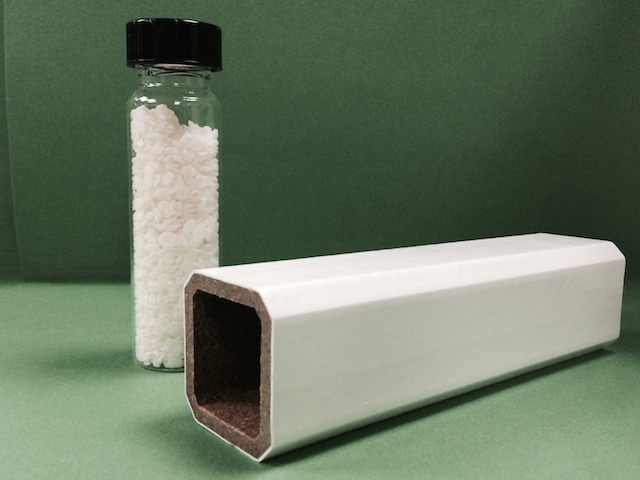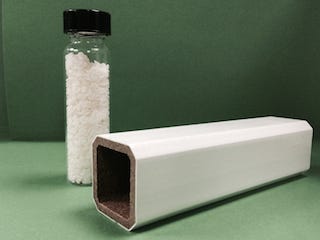Metabolix showcases innovative PVC building and construction materials at Profiles 2015
When you think about biobased materials, you don't typically think of building and construction. However, at the recent Profiles 2015 technology conference on polymer materials in exterior building applications, Metabolix Inc. (Cambridge, MA) showcased just such an innovation: Polymer technology that improves PVC, one of the most widely used materials for building products.Building and construction applications are a "target application space for Metabolix and its PHA (polyhydroxyalkanoate) biopolymer materials," said the company.
September 9, 2015

When you think about biobased materials, you don't typically think of building and construction. However, at the recent Profiles 2015 technology conference on polymer materials in exterior building applications, Metabolix Inc. (Cambridge, MA) showcased just such an innovation: Polymer technology that improves PVC, one of the most widely used materials for building products.
Building and construction applications are a "target application space for Metabolix and its PHA (polyhydroxyalkanoate) biopolymer materials," said the company.
 Lynne Brum, Vice President, Marketing and Corporate Communications, told PlasticsToday that it was in 2012 that the company began taking another look at PHA and thinking through some of the applications that would be possible—beyond biobased and biodegradable ones. "PVC is a brittle polymer and requires additives to achieve the performance needed for commercial applications," she explained. "We found that our PHA biopolymers are very miscible with PVC. PHA is a high-molecular-weight molecule and so is PVC; they mix together very well and have some interesting applications."
Lynne Brum, Vice President, Marketing and Corporate Communications, told PlasticsToday that it was in 2012 that the company began taking another look at PHA and thinking through some of the applications that would be possible—beyond biobased and biodegradable ones. "PVC is a brittle polymer and requires additives to achieve the performance needed for commercial applications," she explained. "We found that our PHA biopolymers are very miscible with PVC. PHA is a high-molecular-weight molecule and so is PVC; they mix together very well and have some interesting applications."
PHA biopolymers can improve PVC processing as well as a range of performance attributes, such as flex modulus, fungal resistance and plasticization. In the beginning of Metabolix's research in this area, Yelena Kann, PhD, looked at PHA in crystalline and rubber forms. "She was trying to evaluate whether the rubber or amorphous form of PHA had a different performance profile and target applications than the crystalline form," said Brum.
Kann discovered some unique properties when PVC and PHA are mixed. Notably, she found that PVC modifiers do not migrate, extract or volatilize, and that they are easy to handle and process under the same conditions as PVC. "Because of that mixing of PVC and PHA at low loading levels, we have some interesting data," Brum said.
One application that performed successfully during testing and trials is PVC flooring in which PHA was added. The testing was done for a major U.S. flooring customer using 100% PVC recyclate in the backing materials. In this application, the PHA acts as a fusion aid, wherein the PHA enhances the properties of the recycled PVC. "The customer wants to see if we can develop a formulation that incorporates only recycled PVC and still achieve the appropriate finish, performance and durability," said Brum. "Using PHA as a fusion aid in recycled PVC results in a surface finish that is smooth and even, and the customer is happy with the performance. The PHA is a compatabilizer—the material makes everything in the formulation work better together."
Metabolix is testing a PVC/WPC (wood-plastic composite) material for decking and railing applications. Working with Integrity Composites LLC, and its compounder Otech Corp., Metabolix has helped the companies formulate a WPC that contains both PVC and wood flour, at a very low loading level of PHA. "With the PHA additive, we found that we can use less PVC and more wood flour, which results in a strong railing with a cost benefit to the formulation," Brum noted. Launch of this product by Integrity is currently underway.
Another application is roofing membranes. Metabolix has done comparisons between PHA as a process aid additive and Elvaloy, a product made by DuPont. "The roofing customer is looking to achieve better processing for the material and for permanence, another feature of PHA," said Brum. "Because of the miscibility of PHA and the good mixing that occurs in the materials, you don't get components of the formulation coming out of the mixture—they're locked in. Smaller molecule additives have a tendency to rise to the surface. It also has good UV resistance and we have shown that the material resists mildew and mold formation, as well as biodegradation."
Max Senechal, Vice President of Strategy and Commercial Development at Metabolix, stated, "Our research shows that when used as a PVC modifier, Metabolix's PHA biopolymers can offer significant value to PVC formulations. The Profiles 2015 conference helped jumpstart new and meaningful conversations with the building materials and construction industry. We look forward to updating this key audience on the new developments at Metabolix involving the use of our PHA biopolymer materials in PVC."
About the Author(s)
You May Also Like




